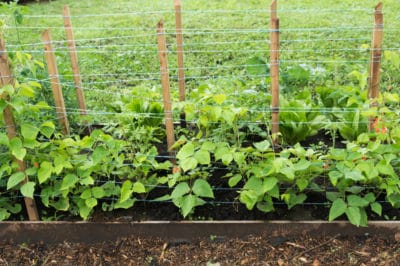Advantages of a Trellis
One of the most important aspects of using a trellis is that it improves exposure to sunlight. A trellis also keeps vines off the ground, where they would quickly become a tangled mess. If you have limited space, a trellis allows you to grow more food in the same area. Finally, trellising your beans makes them much easier to harvest.
Trellis Characteristics
Green bean trellises come in all sizes and shapes. However, all must incorporate one important quality – they must be strong and sturdy to support the weight of vines. Aside from that, they can be purely functional, like a metal fence panel wired to upright posts. In other cases, they can be highly decorative, like a white-painted lattice arch or elaborate wrought iron teepee.
Choosing Beans for a Trellis
Green beans are readily available in more colors than green:
- Kentucky Blue – old favorite known for flavor.
- Goldmarie Vining – bright yellow Italian bean with flat pods.
- Royalty Purple Pod – beans are a deep purple that turn green when cooked.
- Rattlesnake – purple-streaked green bean noted for flavor and productivity.
- Fortex – dark green, early and highly productive.
Should You Build or Buy?
Even someone who has few manual skills can put up a bean trellis. Wire fencing strung on posts provides the beans with support. You can also make a teepee with saplings or bamboo poles. However, garden stores offer very attractive and functional trellises of wood and metal. In the end, it comes down to the time you have available, your financial situation and your preferences.
Trellis Materials
Anything that offers a slightly rough surface for green bean vines to climb is a trellis. Saplings with the bark left on and bamboo poles work well, as do metal fence panels or wire fencing. Bean netting is made from materials like polypropylene and easily removed at the end of the year. Commercial bean towers combine an upright pole with string or twine supports. Wood lattice is another option.
Don’t Forget the Basics
No matter what you choose for a trellis, production will be better if you focus on soil, water and sun. Site your trellis for full sun all day. Prepare the soil well ahead of time with well-rotted leaf mold and aged manure. Make sure your pole beans are well-watered but not water-logged. Pick every day or so to keep the beans coming.
